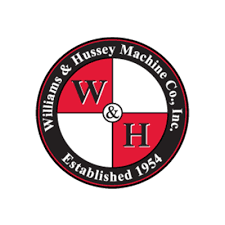
The Williams and Hussey planer-molder is small (7″) in width, but it is open on one side (cantilevered) and is easily able to make round moldings. A special jig is also available to make elliptical moldings. The two horsepower motor is made in the U.S., as is the entire machine. It comes with a boxy steel frame; the motor hangs in that frame. Two rollers for infeed and outfeed reduce snipe to negligible amounts.
Two heavy tube posts on the closed side allow the head to move up and down (the stationary base also helps reduce snipe). One of the nicer touches is the single “pin” removal of the chip deflector/guard so that the cutterhead can be quickly and easily reached. When I say pin, I’m not speaking of lightweight stuff here. This is a sturdy, long steel dowel that slips through holes to hold the cast iron deflector firmly in place, but it can be removed with a slight lift on the front of the guard (taking pressure off the pin), and a firm tug on the round knob handle of the pin. Zip. You’re staring at the two cutting knives.
Blade changes on this machine take about two or three minutes. A step-by-step approach is a good idea, making certain each bolt is tightened down correctly before moving on: the machine turns its arbor at 7000 rpm, with a 15 foot per minute feed rate, so a loose bolt on a knife would be exceptionally hazardous.
The WandH planer/molder can be bought in several packages. The factory package comes with a two horse Baldor motor, the frame, and planer knives already in place. The molder produces a maximum profile depth of 3/4″, and profile widths to 6-3/4″ are possible. The planer works to 7″ wide, and with stock as much as 8″ thick (though you need to add an extension to the crank if you consistently do stock that thick). Williams and Hussey recommends a minimum stock length of 9″, and a minimum thickness of 1/4″ for planing.
The working height (at 31″) is a little low for me.
Assembly went easily, and the machine was a flat out delight to cut molding with. Planing was less easy because the feed angle on boards over 3″ wide tended to bring the boards up against either the posts or the outer edge of the cantilever, leaving a raised ridge on the boards ? forcing a second pass. Then again, that could be cured with a 3/4″ wide guide clamped in place. Moreover, most of those who purchase this machine will probably not use it for planing much of the time.
The cost of the WandH factory package, with a two horse Baldor motor wired with a switch, the stand, and the molder itself is $1,879.
In the end, the WandH planer/molder is a remarkable machine, designed for efficient and fast setup, and built to last a long, long time. And, as you would expect, you pay for both the efficiency and the durability.
-Charles Self





